
应用化学 ›› 2024, Vol. 41 ›› Issue (5): 616-636.DOI: 10.19894/j.issn.1000-0518.230366
• 综合评述 • 上一篇
钠/钾离子电池用锑基负极研究进展:失效分析及解决方案
- 1.中国科学院长春应用化学研究所,稀土资源利用国家重点实验室,长春 130022
2.中国科学技术大学应用化学与工程学院,合肥 230026
-
收稿日期:2023-11-21接受日期:2024-03-31出版日期:2024-05-01发布日期:2024-06-03 -
通讯作者:程勇 -
基金资助:吉林省科技发展计划项目(YDZJ202101ZYTS185);国家自然科学基金(21975250)
Research Progress of Antimony⁃Based Anode for Sodium/Potassium Ion Batteries: Failure Analysis and Solutions
Dong-Yu ZHANG1,2, Chun-Li WANG1, Yong CHENG1( ), Li-Min WANG1,2
), Li-Min WANG1,2
- 1.State Key Laboratory of Rare Earth Resource Utilization,Changchun Institute of Applied Chemistry,Chinese Academy of Sciences,Changchun 130022,China
2.School of Applied Chemistry and Engineering,University of Science and Technology of China,Hefei 230026,China
-
Received:2023-11-21Accepted:2024-03-31Published:2024-05-01Online:2024-06-03 -
Contact:Yong CHENG -
About author:cyong@ciac.ac.cn
-
Supported by:the Science and Technology Development Program of Jilin Province(YDZJ202101ZYTS185);the National Natural Science Foundation of China(21975250)
摘要:
钠/钾离子电池因其丰富的资源储量被认为是后锂离子电池时代大规模储能应用中最有希望的选择。 在众多的钠/钾离子电池负极材料中,锑(Antimony, Sb)基负极由于其高理论比容量受到关注。 然而,Sb基材料在储能过程中存在的棘手问题阻碍了它的实际应用,比如: 巨大的体积膨胀导致材料粉化脱离集流体,电池失效; 欠佳的导电性,电化学动力缓慢; 电极-电解液界面副反应,电池性能差等。为解决这些问题,研究者们从结构设计、掺杂催化改性和电解液界面调控等方面进行了探究,期望将Sb基材料高容量的优势发挥出来。 因此,本文总结了近10年“钠/钾离子电池用Sb基负极”研究方面的亮点工作,详细讨论Sb基材料的失效机理,并系统地综述了相应的解决方案,为高性能Sb基及其他合金类负极材料的优化策略提供参考。
中图分类号:
引用本文
张冬玉, 王春丽, 程勇, 王立民. 钠/钾离子电池用锑基负极研究进展:失效分析及解决方案[J]. 应用化学, 2024, 41(5): 616-636.
Dong-Yu ZHANG, Chun-Li WANG, Yong CHENG, Li-Min WANG. Research Progress of Antimony⁃Based Anode for Sodium/Potassium Ion Batteries: Failure Analysis and Solutions[J]. Chinese Journal of Applied Chemistry, 2024, 41(5): 616-636.
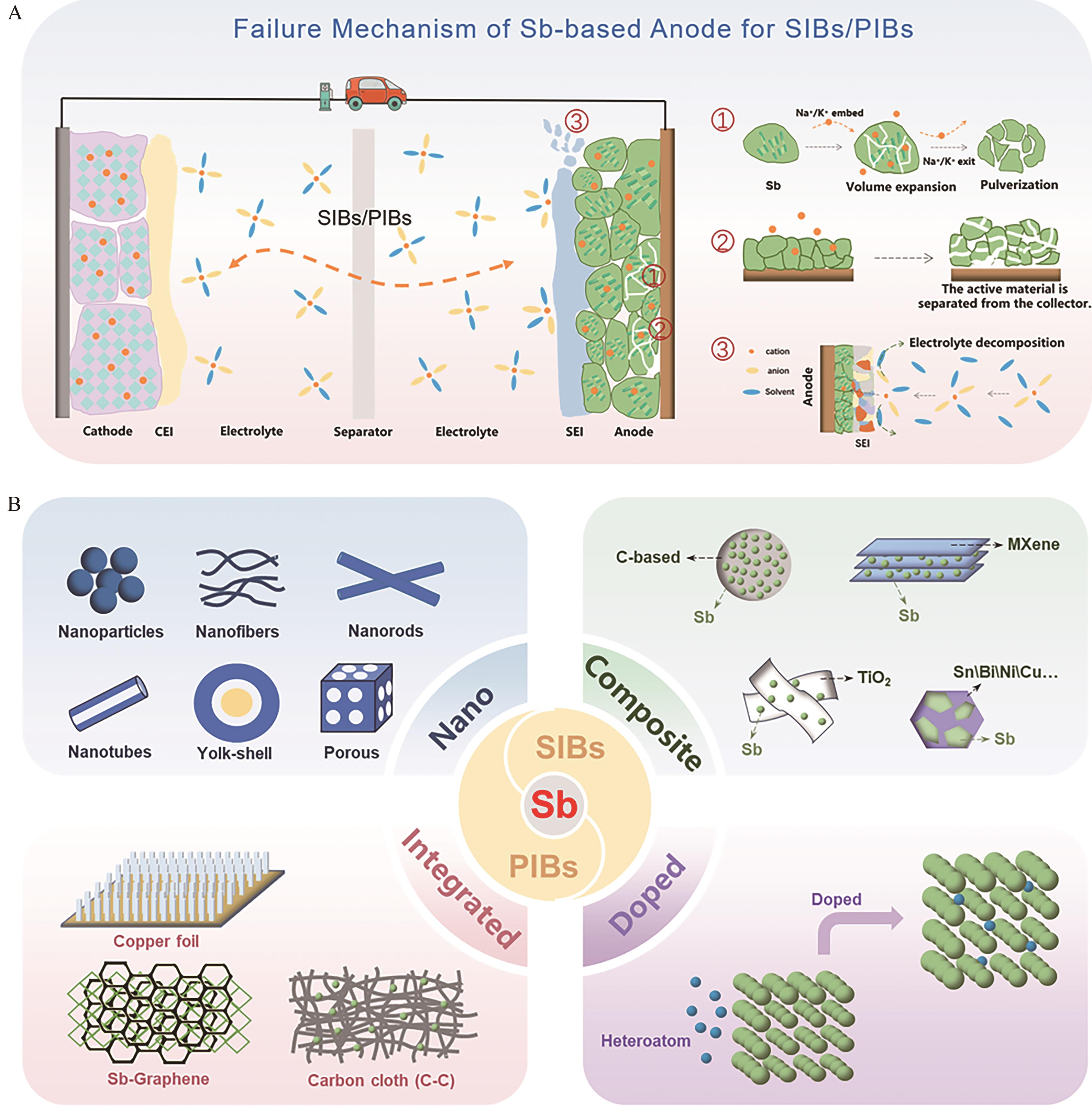
图1 (A) Sb基合金负极失效机理; (B)针对Sb基合金负极失效问题的解决方案
Fig.1 (A) Failure mechanism of Sb-based alloy anode; (B) Solution to the failure problem of Sb-based alloy anode
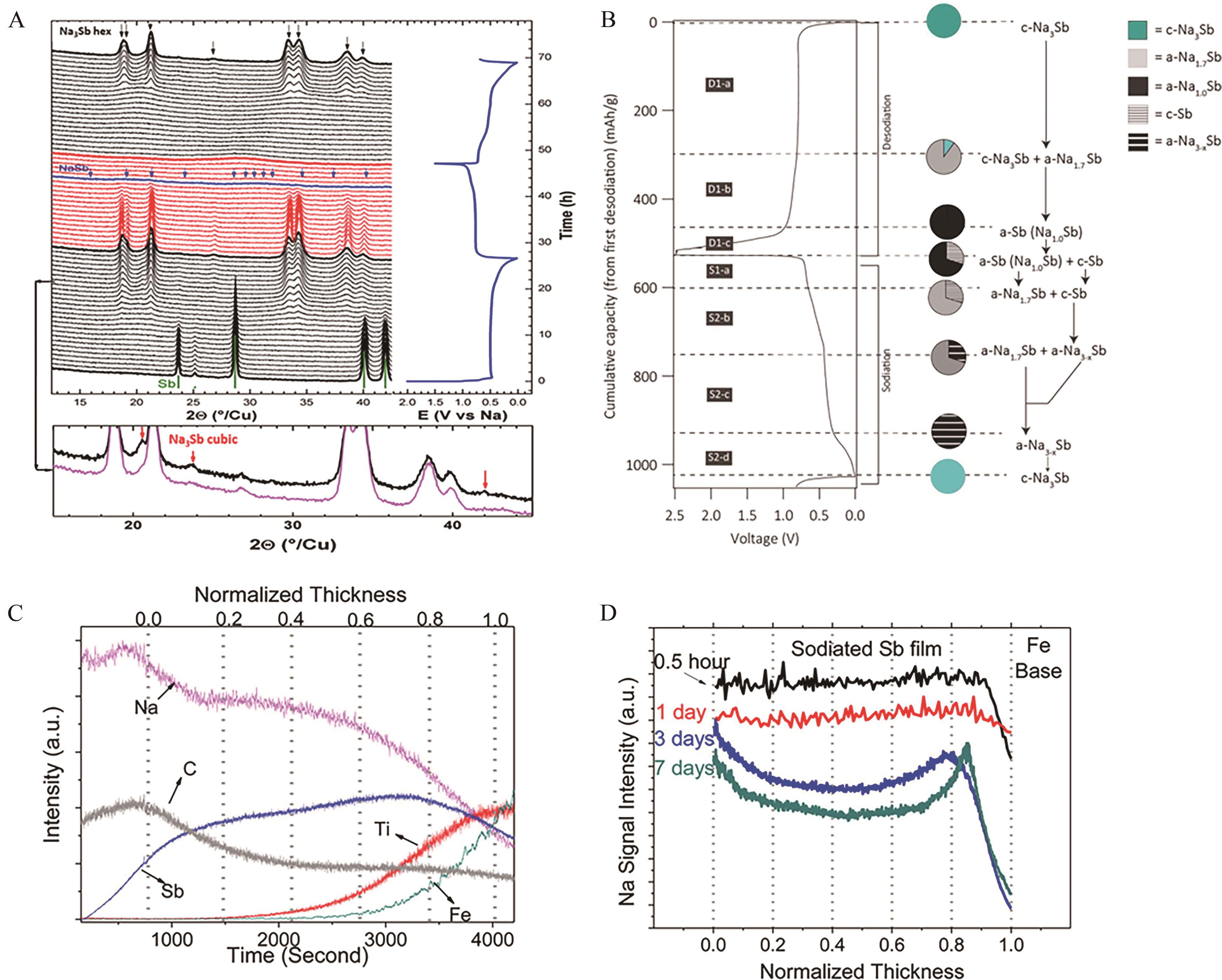
图2 (A)原位XRD衍射谱及对应的电压分布图[18]; (B)恒流循环中以C/20速率第1次脱/嵌钠时锑的PDF和NMR衍生机制[19]; (C) 100 nm Sb和(D) Na信号穿过的TOF-SIMS深度剖面[13]
Fig.2 (A) Operando evolution of the XRD pattern recorded and the corresponding voltage profile[18]; (B) PDF and NMR-derived mechanism of (de)sodiation of antimony from the first (de) sodiation during galvanostatic cycling at a rate of C/20[19]; TOF-SIMS depth profiles through (C) 100 nm Sb and (D) the Na signal across[13]
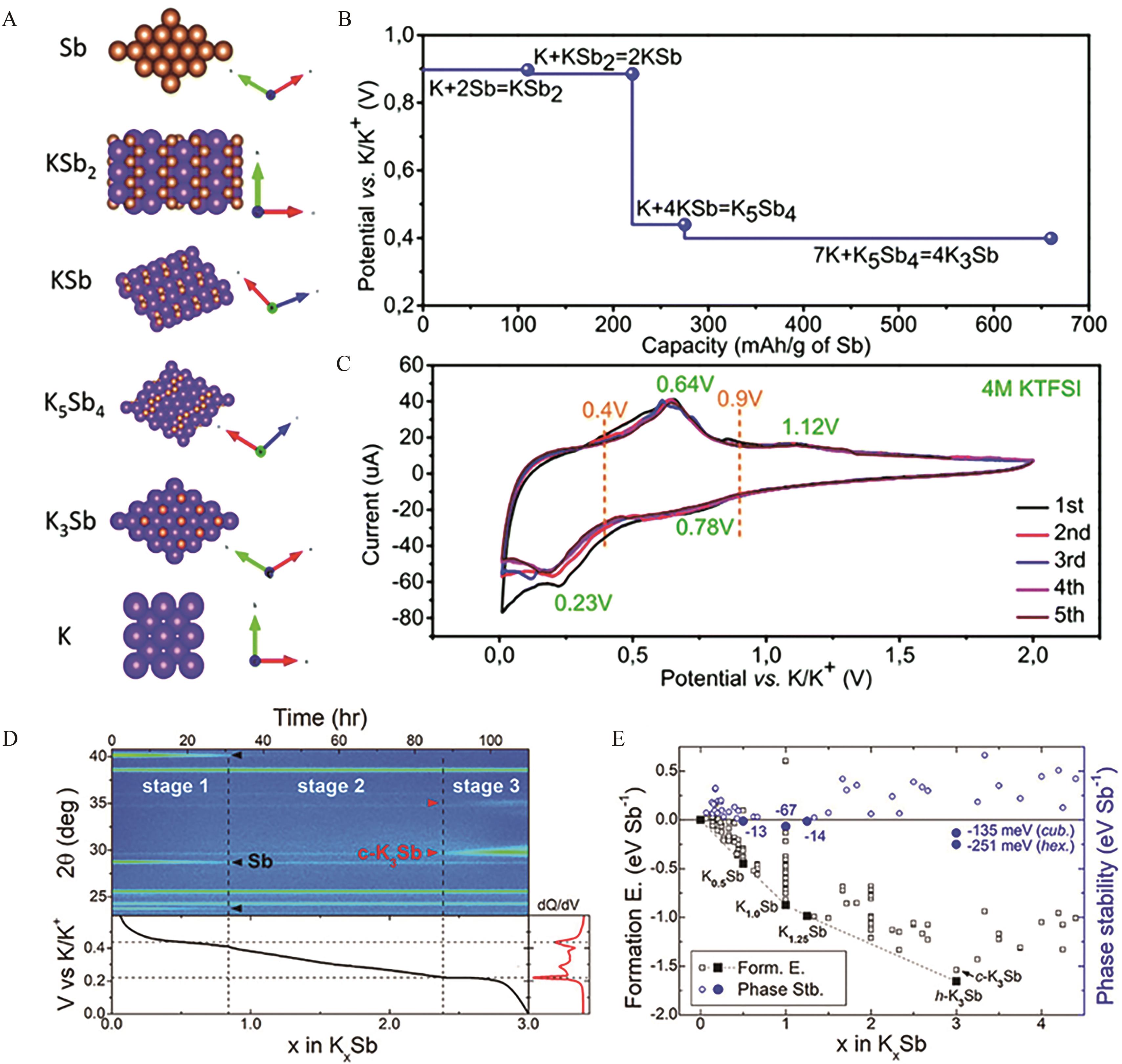
图3 (A) K的晶体结构以及钾化过程结构演化; (B) DFT计算出的钾化过程的平衡电压; (C) Sb@CSN电极的CV曲线[20]; (D)第1次放电的Sb电极的原位XRD及(E)通过离子取代法获得的K x Sb形成能[21]
Fig.3 (A) Crystal structure of K and the structure evolution during the potassiation process; (B) DFT calculated equilibrium voltages for the potassiation process; (C) CV curves for the Sb@CSN electrode [20]; (D) In situ XRD measurement of an Sb electrode for the first discharge and (E) formation energies of K x Sb obtained by the ionic substitution method[21]

图4 (A) Sb2S3的原位XRD等值线图[26]; (B)类似火箭发射的纳米颗粒相演化生长示意图及相应的(C) TEM图像和(D)电子衍射图[27]
Fig.4 (A) Contour plot of the operando XRD of Sb2S[26]; (B) Schematic drawing showing the rocket-launching-like nanoparticle growth along with phase evolution during potassiation process and corresponding (C) TEM and (D) SAED[27] images
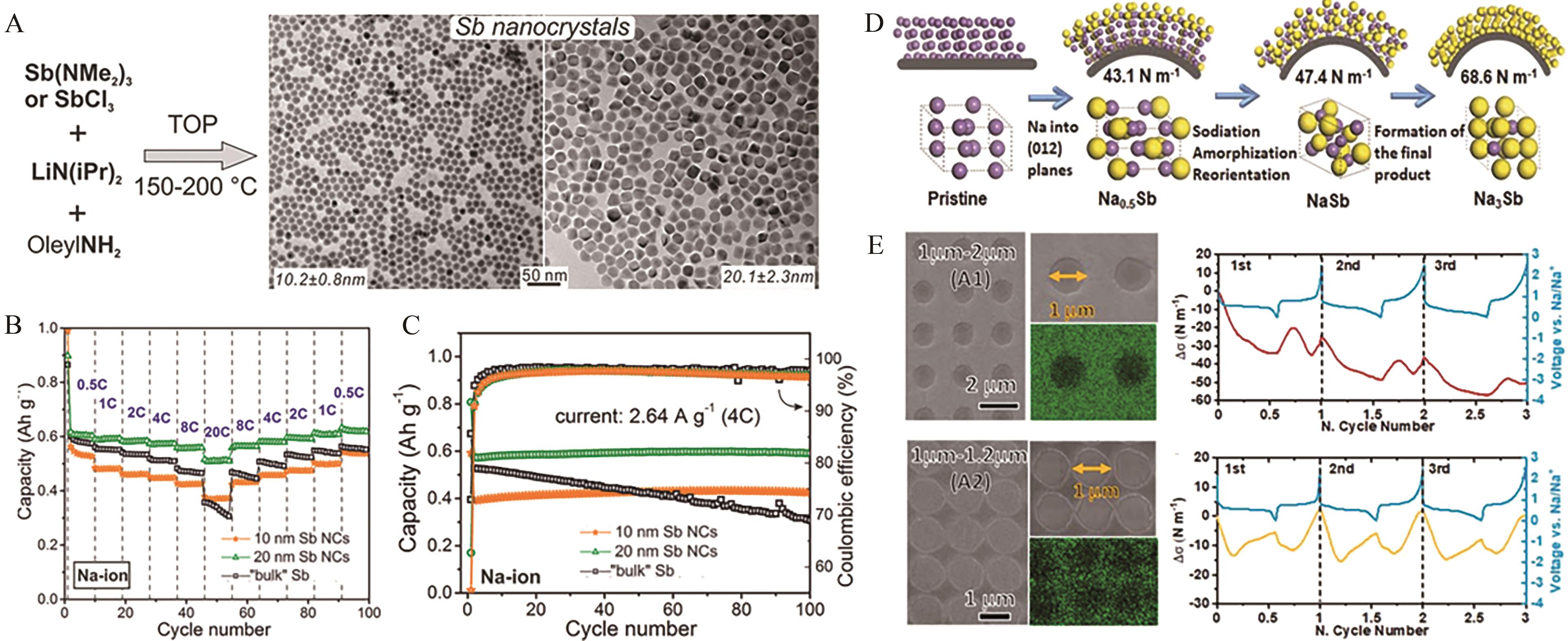
图5 (A)单分散锑纳米晶体的合成及TEM图及(B)倍率性能和(C)循环性能[38]; (D) Sb薄膜包覆的MCL和钠化过程的界面应力示意图及(E)创建空隙图案阵列以缓冲应力累积[39]
Fig.5 (A) Synthesis of monodisperse Sb nanocrystals with TEM image and (B) rate performance and (C) cycle performance[38]; (D) Schematics of the Sb thin film coated MCL and the interfacial stress during the sodiation and (E) patterned arrays of voids are created to buffer the stress accumulation[39]

图6 (A) Sb@C微球的制备过程示意图[53]; (B) Sb@Void@GDY NB制备过程示意[56]
Fig.6 (A) Schematic illustration of the preparation process of the Sb@C microspheres[53]; (B) Schematic illustration of the preparation process of Sb@Void@GDY NB[56]

图7 (A) 碳包覆Sb/MXene (CSM)杂化材料的制备示意图[68]; (B) Sb/Na-Ti3C2T x 杂化物的制备示意图[69]
Fig.7 (A) Schematic illustration for the preparation of carbon-coated Sb/MXene (CSM) hybrid[68]; (B) Schematic illustration for the preparation of Sb/Na-Ti3C2T x hybrid[69]
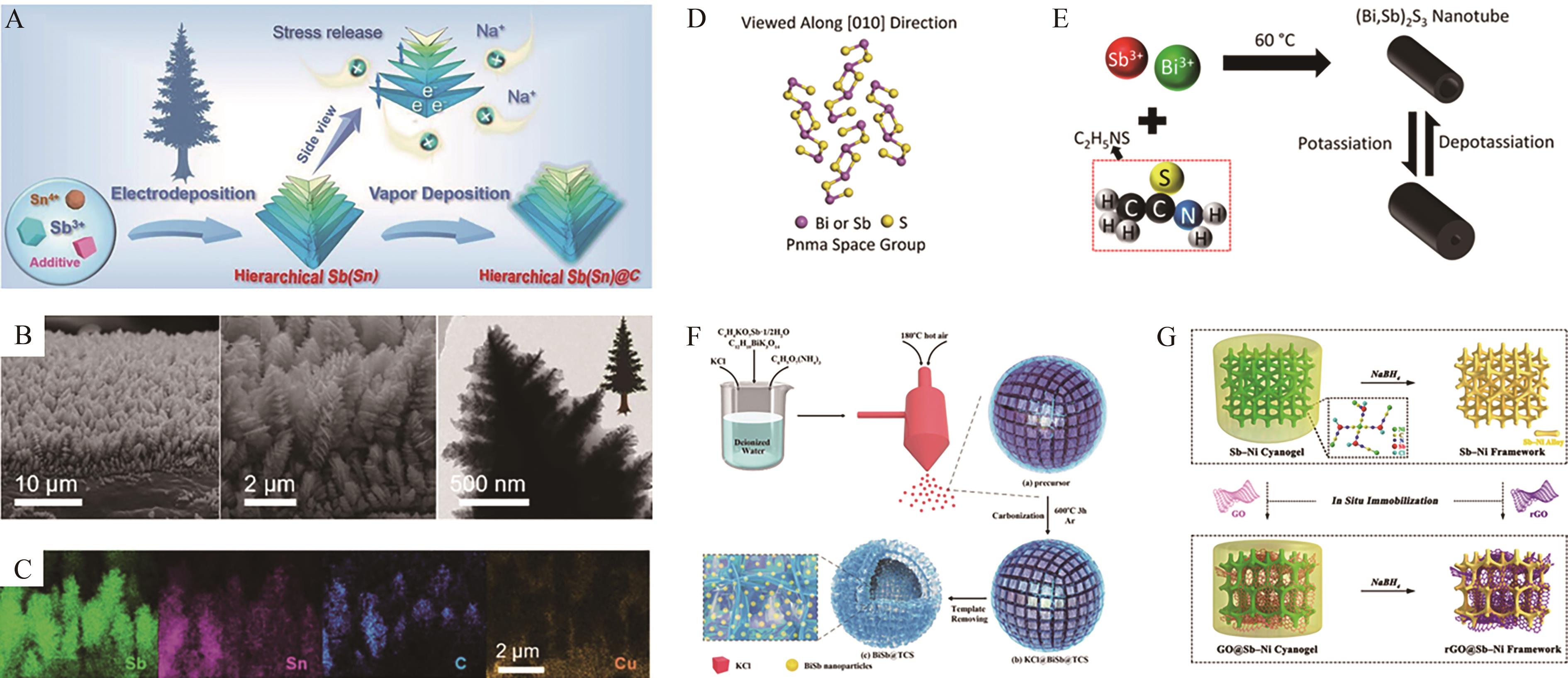
图8 ( A、B、C) Sb(Sn)@C的合成过程、形貌和结构分析[72]; (D) Bi2S3和Sb2S3晶体结构图及(E) (Bi,Sb)2S3纳米管的合成过程[76]; (F) BiSb@TCS[77]和(G) rGO@Sb-Ni骨架[79]的制备过程示意图
Fig.8 (A, B, C) Synthesis, morphology, and structure analyses of the Sb(Sn)@C sample[72]; (D) Illustration of the crystal structure of Bi2S3 and Sb2S3 and (E) the synthesis procedures of (Bi,Sb)2S3 nanotubes[76]; Schematic illustration for the preparation of (F) BiSb@TCS[77] and (G) rGO@Sb-Ni framework[79]
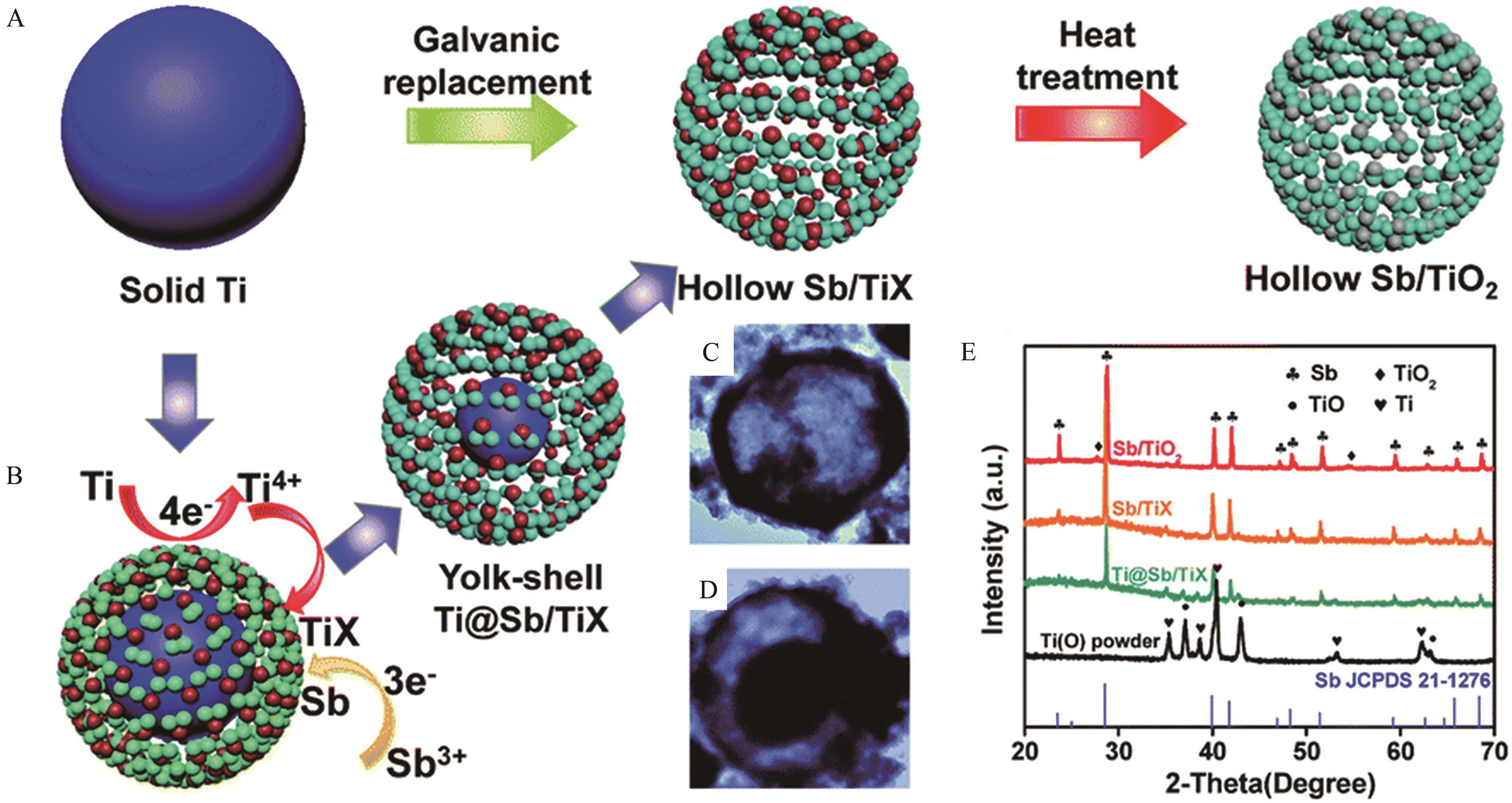
图9 (A)空心交织结构Sb/TiO2的合成示意图; (B)从Ti模到空心Sb/Ti x 中间体的纳米限制电取代的图示; (C、D)中空结构 Sb/Ti x 和蛋黄壳Ti@Sb/Ti x 的TEM图像及(E) XRD[80]
Fig.9 (A) Schematic drawing of hollow interwoven structured Sb/TiO2; (B) Illustration of nanoconfined galvanic replacement from a Ti template to hollow Sb/Ti x intermediates, TEM images of (C) hollow structured Sb/Ti x and (D) yolk-shell Ti@Sb/Ti x and (E) XRD[80]
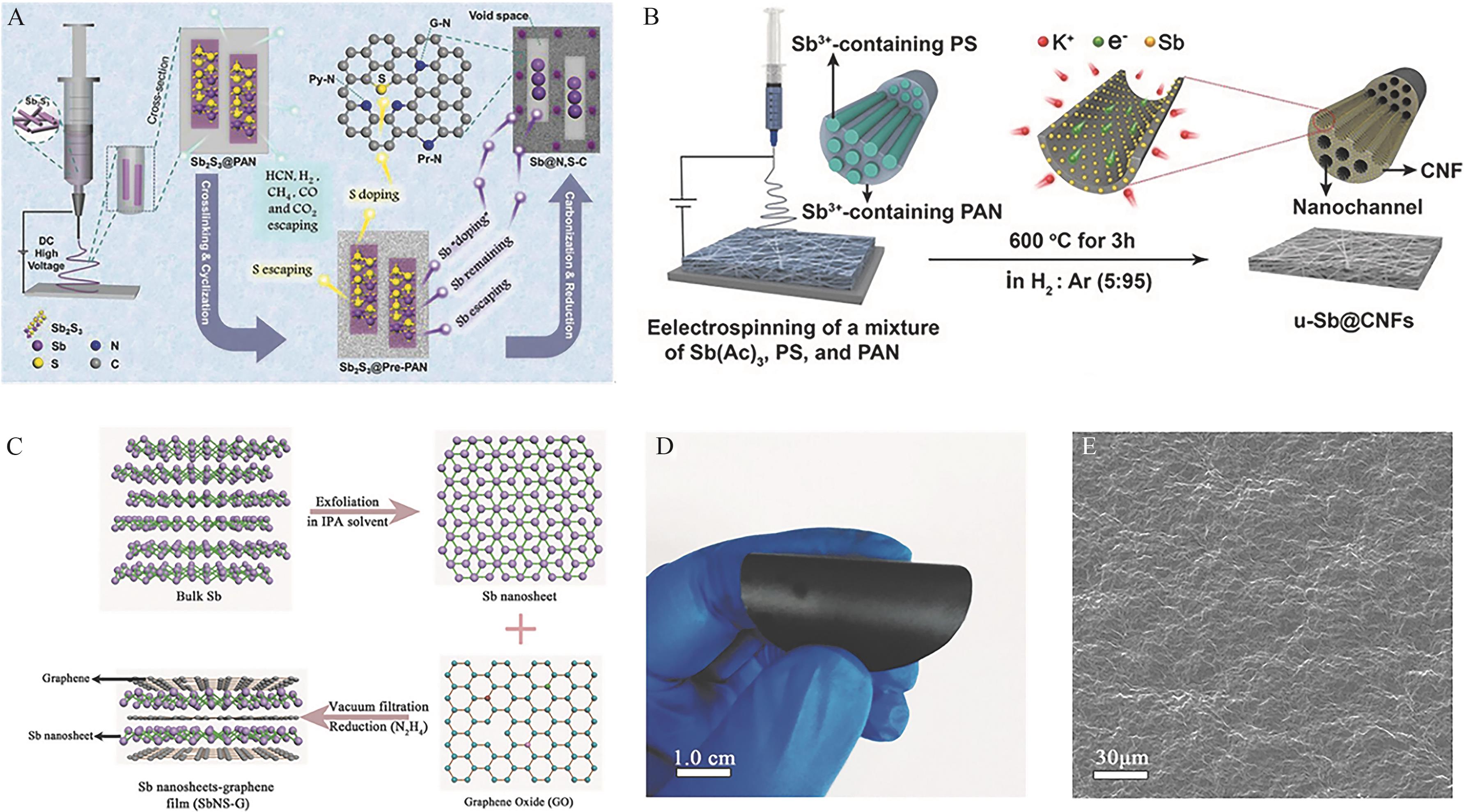
图10 (A) Sb@N,S-CNF合成过程示意图[91]; (B) u-Sb@CNF合成过程示意图[92]; (C) SbNS-G薄膜的制备过程示意图及(D)数码照片和(E) SEM图像[95]
Fig.10 (A) Schematic illustration of the synthesis process of Sb@N,S-CNFs[91]; (B) Schematic illustration of the synthesis process of u-Sb@CNF[92]; (C) Schematic illustration of the fabrication process of SbNS-G film and (D) Typical digital photograph and (E) SEM image[95]
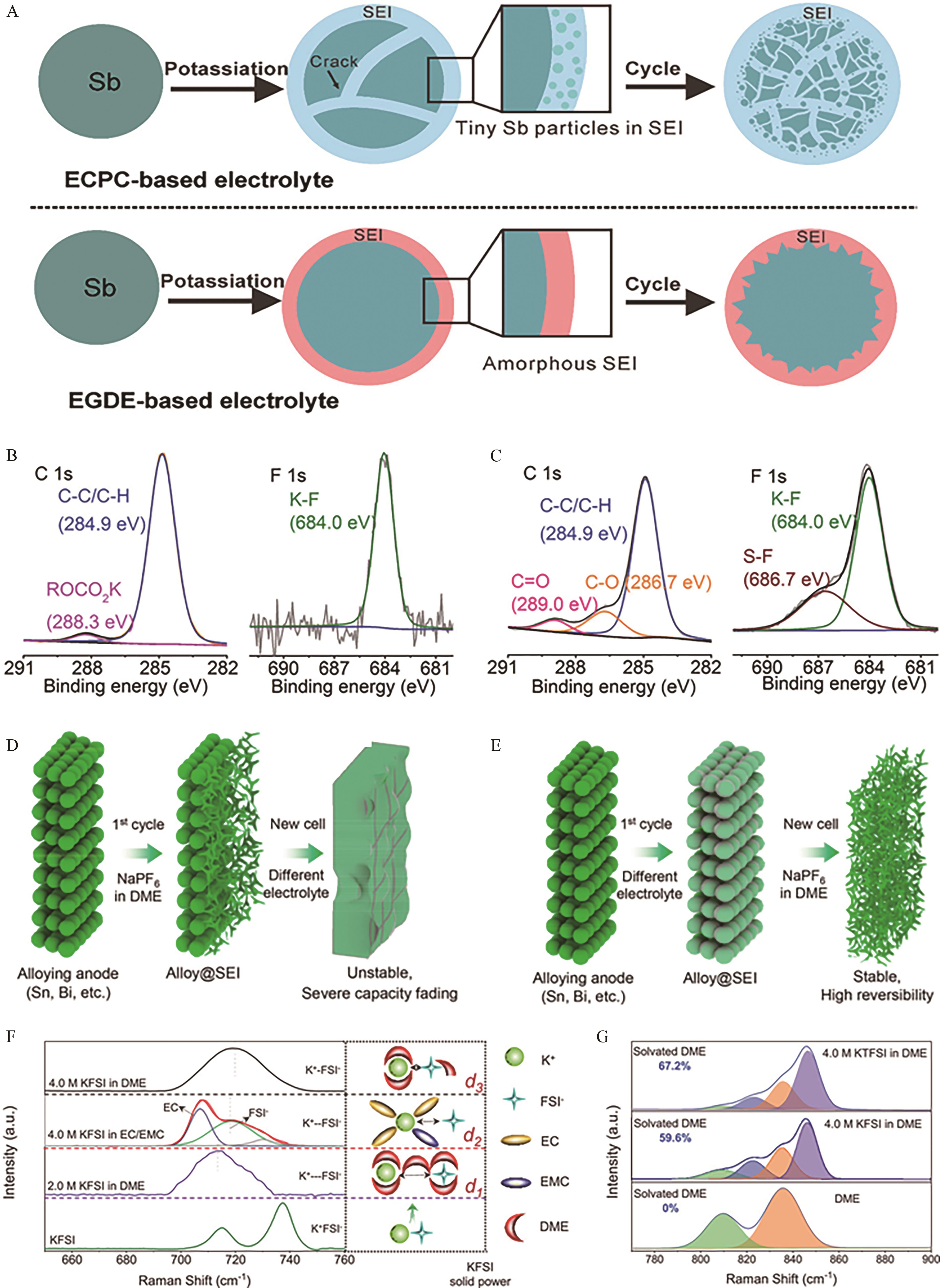
图11 (A) ECPC和EGDE基电解质中电极/SEI演变的图示; (B) 1 mol/L KFSI/ECPC和(C) 1 mol/L KFSI/EGDE电解质中循环3次后Sb电极的XPS谱[99]; (D、E)电解液交换实验示意图[100]; (F、G)电解液拉曼光谱[101]
Fig.11 (A) Illustration of electrode/SEI evolution in ECPC (up) and EGDE-based (down) electrolytes; XPS spectra of Sb electrodes after cycling three times in (B) 1 mol/L KFSI/ECPC and (C) 1 mol/L KFSI/EGDE electrolytes[99]; (D, E) Schematic diagram of electrolyte exchange experiment[100]; (F, G) Raman spectra of electrolyte[101]
表1 不同Sb基材料的改性方法及储钠性能的对比
Table 1 Comparison of the modification method and Na+ storage performances for the different Sb?based materials
表2 不同Sb基材料的改性方法及储钾性能的对比
Table 2 Comparison of the modification method and K+ storage performances for the different Sb?based materials
| 1 | YABUUCHI N, KUBOTA K, DAHBI M, et al. Research development on sodium-ion batteries[J]. Chem Rev, 2014, 114(23): 11636-11682. |
| 2 | SLATER M D, KIM D, LEE E, et al. Sodium-ion batteries[J]. Adv Funct Mater, 2013, 23(8): 947-958. |
| 3 | KUBOTA K, DAHBI M, HOSAKA T, et al. Towards K-ion and Na-ion batteries as “beyond Li-ion”[J]. Chem Rec, 2018, 18(4): 459-479. |
| 4 | HWANG J Y, MYUNG S T,SUN Y K. Recent progress in rechargeable potassium batteries[J]. Adv Funct Mater, 2018, 28(43): 1802938. |
| 5 | WANG B, ANG E H, YANG Y, et al. Post-lithium-ion battery era: recent advances in rechargeable potassium-ion batteries[J]. Chem-Eur J, 2021, 27(2): 512-536. |
| 6 | MA L, LV Y, WU J, et al. Recent advances in anode materials for potassium-ion batteries: a review[J]. Nano Res, 2021, 14(12): 4442-4470. |
| 7 | WU Y, SUN Y, TONG Y, et al. Recent advances in potassium-ion hybrid capacitors: electrode materials, storage mechanisms and performance evaluation[J]. Energy Storage Mater, 2021, 41: 108-132. |
| 8 | HOSAKA T, KUBOTA K, HAMEED A S, et al. Research development on K-ion batteries[J]. Chem Rev, 2020, 120(14): 6358-6466. |
| 9 | LIU Z, SONG T, PAIK U. Sb-based electrode materials for rechargeable batteries[J]. J Mater Chem A, 2018, 6(18): 8159-8193. |
| 10 | SUBRAMANYAN K,ARAVINDAN V. Stibium: a promising electrode toward building high-performance Na-ion full-cells[J]. Chem, 2019, 5(12): 3096-3126. |
| 11 | QI S H, DENG J W, ZHANG W C, et al. Recent advances in alloy-based anode materials for potassium ion batteries[J]. Rare Met, 2020, 39(9): 970-988. |
| 12 | GAO H, GUO X, WANG S, et al. Antimony-based nanomaterials for high-performance potassium-ion batteries[J]. EcoMat, 2020, 2(2): e12027. |
| 13 | LI Z, TAN X, LI P, et al. Coupling in situ tem and ex situ analysis to understand heterogeneous sodiation of antimony[J]. Nano Lett, 2015, 15(10): 6339-6348. |
| 14 | JING W T, YANG C C, JIANG Q. Recent progress on metallic Sn- and Sb-based anodes for sodium-ion batteries[J]. J Mater Chem A, 2020, 8(6): 2913-2933. |
| 15 | SARKAR S, ROY S, ZHAO Y, et al. Recent advances in semimetallic pnictogen (As, Sb, Bi) based anodes for sodium-ion batteries: structural design, charge storage mechanisms, key challenges and perspectives[J]. Nano Res, 2021, 14(11): 3690-3723. |
| 16 | LIANG S, CHENG Y J, ZHU J, et al. A chronicle review of nonsilicon (Sn, Sb, Ge)-based lithium/sodium-ion battery alloying anodes[J]. Small Methods, 2020, 4(8): 2000218. |
| 17 | LI Y, LAI X, QU J, et al. Research progress in regulation strategies of high-performance antimony-based anode materials for sodium ion batteries[J]. Acta Phys-Chim Sin, 2022, 38(11): 2204049-2204040. |
| 18 | DARWICHE A, MARINO C, SOUGRATI M T, et al. Better cycling performances of bulk Sb in Na-ion batteries compared to Li-ion systems: an unexpected electrochemical mechanism[J]. J Am Chem Soc, 2012, 134(51): 20805-20811. |
| 19 | ALLAN P K, GRIFFIN J M, DARWICHE A, et al. Tracking sodium-antimonide phase transformations in sodium-ion anodes: insights from operando pair distribution function analysis and solid-state nmr spectroscopy[J]. J Am Chem Soc, 2016, 138(7): 2352-2365. |
| 20 | ZHENG J, YANG Y, FAN X, et al. Extremely stable antimony-carbon composite anodes for potassium-ion batteries[J]. Energy Environ Sci, 2019, 12(2): 615-623. |
| 21 | KO Y N, CHOI S H, KIM H, et al. One-pot formation of Sb-carbon microspheres with graphene sheets: potassium-ion storage properties and discharge mechanisms[J]. ACS Appl Mater Interfaces, 2019, 11(31): 27973-27981. |
| 22 | LU Y,CHEN J. Robust self-supported anode by integrating Sb2S3 nanoparticles with S,N-codoped graphene to enhance K-storage performance[J]. Sci China Chem, 2017, 60(12): 1533-1539. |
| 23 | YE J, XIA G, ZHENG Z, et al. Facile controlled synthesis of coral-like nanostructured Sb2O3@Sb anode materials for high performance sodium-ion batteries[J]. Int J Hydrogen Energy, 2020, 45(16): 9969-9978. |
| 24 | HOU H, JING M, HUANG Z, et al. One-dimensional rod-like Sb2S3-based anode for high-performance sodium-ion batteries[J]. ACS Appl Mater Interfaces, 2015, 7(34): 19362-19369. |
| 25 | SHENG B, WANG L, HUANG H, et al. Boosting potassium storage by integration advantageous of defect engineering and spatial confinement: a case study of Sb2Se3[J]. Small, 2020, 16(49): e2005272. |
| 26 | WANG T, SHEN D, LIU H, et al. A Sb2S3 nanoflower/MXene composite as an anode for potassium-ion batteries[J]. ACS Appl Mater Interfaces, 2020, 12(52): 57907-57915. |
| 27 | CHENG Y, YAO Z, ZHANG Q, et al. In situ atomic-scale observation of reversible potassium storage in Sb2S3@carbon nanowire anodes[J]. Adv Funct Mater, 2020, 30(52): 2005417. |
| 28 | SHIVA K, RAJENDRA H B,BHATTACHARYYA A J. Electrospun snsb crystalline nanoparticles inside porous carbon fibers as a high stability and rate capability anode for rechargeable batteries[J]. ChemPlusChem, 2015, 80(3): 516-521. |
| 29 | KALISVAART W P, CHAUDHARY M, BHATTACHARYA A, et al. Mixing, domains, and fast Li-ion dynamics in ternary Li-Sb-Bi battery anode alloys[J]. J Phys Chem C, 2022, 126(5): 2394-2402. |
| 30 | GANDI S, CHINTA S R, GHOSHAL P, et al. SnO-GeO2-Sb2O3 glass anode network mixed with different Ba2+ fractions: investigations on Na-ion storage capacity and stability[J]. J Non-cryst Solids, 2019, 506: 80-87. |
| 31 | KIM I T, ALLCORN E,MANTHIRAM A. High-performance MxSb-Al2O3-C (M=Fe, Ni, and Cu) nanocomposite-alloy anodes for sodium-ion batteries[J]. Energy Technol, 2013, 1(5/6): 319-326. |
| 32 | LU X, WANG Z, LIU K, et al. Hierarchical Sb2MoO6 microspheres for high-performance sodium-ion battery anode[J]. Energy Storage Mater, 2019, 17: 101-110. |
| 33 | NAGULAPATI V M, LEE J H, KIM H S, et al. Novel hybrid binder mixture tailored to enhance the electrochemical performance of SbTeBi-metallic anode for sodium ion batteries[J]. J Electroanal Chem, 2020, 865: 114160. |
| 34 | ZHENG X M, YOU J H, FAN J J, et al. Electrodeposited binder-free Sb/NiSb anode of sodium-ion batteries with excellent cycle stability and rate capability and new insights into its reaction mechanism by operando xrd analysis[J]. Nano Energy, 2020, 77: 105123. |
| 35 | YANG L, GUO L, YAN D, et al. Understanding the highly reversible potassium storage of hollow ternary (Bi-Sb)2S3@N-C nanocube[J]. ACS Nano, 2023, 17(7): 6754-6769. |
| 36 | YANG Y, WANG J, LIU S, et al. Nature of bismuth and antimony based phosphate nanobundles/graphene for superior potassium ion batteries[J]. Chem Eng J, 2022, 435: 134746. |
| 37 | XIONG P, WU J, ZHOU M, et al. Bismuth-antimony alloy nanoparticle@porous carbon nanosheet composite anode for high-performance potassium-ion batteries[J]. ACS Nano, 2020, 14(1): 1018-1026. |
| 38 | HE M, KRAVCHYK K, WALTER M, et al. Monodisperse antimony nanocrystals for high-rate Li-ion and Na-ion battery anodes: nano versus bulk[J]. Nano Lett, 2014, 14(3): 1255-1262. |
| 39 | JIANG K, TAN X, ZHANG W, et al. Localized anisotropic stress in the sodiation of antimony anode[J]. Nano Energy, 2022, 98: 107349. |
| 40 | WANG X, SONG J, QU J. Antimonene: from experimental preparation to practical application[J]. Angew Chem Int Ed Engl, 2019, 58(6): 1574-1584. |
| 41 | GUO S, HU X, ZHOU W, et al. Mechanistic understanding of two-dimensional phosphorus, arsenic, and antimony high-capacity anodes for fast-charging lithium/sodium ion batteries[J]. J Phys Chem C, 2018, 122(51): 29559-29566. |
| 42 | CHANG C, CHEN W, CHEN Y, et al. Recent progress on two-dimensional materials[J]. Acta Phys-Chim Sin, 2021, 37(12): 2108017. |
| 43 | ZHANG S, ZHOU W, MA Y, et al. Antimonene oxides: emerging tunable direct bandgap semiconductor and novel topological insulator[J]. Nano Lett, 2017, 17(6): 3434-3440. |
| 44 | HONG G, ZHOU M, ZHANG R, et al. Separation of metallic and semiconducting single-walled carbon nanotube arrays by “scotch tape”[J]. Angew Chem Int Ed Engl, 2011, 50(30): 6819-6823. |
| 45 | TIAN W, ZHANG S, HUO C, et al. Few-layer antimonene: anisotropic expansion and reversible crystalline-phase evolution enable large-capacity and long-life Na-ion batteries[J]. ACS Nano, 2018, 12(2): 1887-1893. |
| 46 | YANG Y, LENG S,SHI W. Electrochemical exfoliation of porous antimonene as anode materials for sodium-ion batteries[J]. Electrochem Commun, 2021, 126: 107025. |
| 47 | LIU Y, TAI Z, ZHANG J, et al. Boosting potassium-ion batteries by few-layered composite anodes prepared via solution-triggered one-step shear exfoliation[J]. Nat Commun, 2018, 9(1): 3645. |
| 48 | HOU H, JING M, YANG Y, et al. Sodium/lithium storage behavior of antimony hollow nanospheres for rechargeable batteries[J]. ACS Appl Mater Interfaces, 2014, 6(18): 16189-16196. |
| 49 | ZHANG H, AN W, SONG H, et al. Synthesis of micro-sized porous antimony via vapor dealloying for high-performance Na-ion battery anode[J]. Solid State Ionics, 2020, 352: 115365. |
| 50 | LI M, QIU T, FOUCHER A C, et al. Impact of hierarchical nanoporous architectures on sodium storage in antimony-based sodium-ion battery anodes[J]. ACS Appl Energy Mater, 2020, 3(11): 11231-11241. |
| 51 | AN Y, TIAN Y, CI L, et al. Micron-sized nanoporous antimony with tunable porosity for high-performance potassium-ion batteries[J]. ACS Nano, 2018, 12(12): 12932-12940. |
| 52 | ZHANG X, LI F, WU P, et al. Facile fabrication of sheet-on-sheet hierarchical nanostructured Sb/C composite with boosting sodium storage[J]. J Colloid Interface Sci, 2019, 545: 200-208. |
| 53 | QIU S, WU X, XIAO L, et al. Antimony nanocrystals encapsulated in carbon microspheres synthesized by a facile self-catalyzing solvothermal method for high-performance sodium-ion battery anodes[J]. ACS Appl Mater Interfaces, 2016, 8(2): 1337-1343. |
| 54 | LIU Z, YU X Y, LOU X W, et al. Sb@C coaxial nanotubes as a superior long-life and high-rate anode for sodium ion batteries[J]. Energy Environ Sci, 2016, 9(7): 2314-2318. |
| 55 | DUAN J, ZHANG W, WU C, et al. Self-wrapped Sb/C nanocomposite as anode material for high-performance sodium-ion batteries[J]. Nano Energy, 2015, 16: 479-487. |
| 56 | LIU Y, QING Y, ZHOU B, et al. Yolk-shell Sb@void@graphdiyne nanoboxes for high-rate and long cycle life sodium-ion batteries[J]. ACS Nano, 2023, 17(3): 2431-2439. |
| 57 | JI F, LIU T, LI Y, et al. Ball-milling strategy for fast and stable potassium-ion storage in antimony-carbon composite anodes[J]. ChemElectroChem, 2020, 7(22): 4587-4593. |
| 58 | HE X D, LIU Z H, LIAO J Y, et al. A three-dimensional macroporous antimony@carbon composite as a high-performance anode material for potassium-ion batteries[J]. J Mater Chem A, 2019, 7(16): 9629-9637. |
| 59 | YI Z, FANG D, ZHANG W, et al. Revealing quasi-1d volume expansion in Na-/K-ion battery anodes: a case study of Sb2O3 microbelts[J]. CCS Chem, 2021, 3(5): 1306-1315. |
| 60 | XIONG X, WANG G, LIN Y, et al. Enhancing sodium ion battery performance by strongly binding nanostructured Sb2S3 on sulfur-doped graphene sheets[J]. ACS Nano, 2016, 10(12): 10953-10959. |
| 61 | WANG S, XIONG P, GUO X, et al. A stable conversion and alloying anode for potassium-ion batteries: a combined strategy of encapsulation and confinement[J]. Adv Funct Mater, 2020, 30(27): 2001588. |
| 62 | FANG Y, LIAN R, LI H, et al. Induction of planar sodium growth on MXene (Ti3C2Tx)-modified carbon cloth hosts for flexible sodium metal anodes[J]. ACS Nano, 2020, 14(7): 8744-8753. |
| 63 | ASLAM M K,XU M. A mini-review: MXene composites for sodium/potassium-ion batteries[J]. Nanoscale, 2020, 12(30): 15993-16007. |
| 64 | ZUO D C, SONG S C, AN C S, et al. Synthesis of sandwich-like structured Sn/SnOx@MXene composite through in-situ growth for highly reversible lithium storage[J]. Nano Energy, 2019, 62: 401-409. |
| 65 | GUO X, XIE X, CHOI S, et al. Sb2O3/MXene(Ti3C2Tx) hybrid anode materials with enhanced performance for sodium-ion batteries[J]. J Mater Chem A, 2017, 5(24): 12445-12452. |
| 66 | ARNOLD S, GENTILE A, LI Y, et al. Design of high-performance antimony/MXene hybrid electrodes for sodium-ion batteries[J]. J Mater Chem A, 2022, 10(19): 10569-10585. |
| 67 | ZHANG P, ZHU Q, WEI Y, et al. Achieving stable and fast potassium storage of Sb2S3@MXene anode via interfacial bonding and electrolyte chemistry[J]. Chem Eng J, 2023, 451: 138891. |
| 68 | TIAN X, ZHANG P, LIAO Y, et al. Achieving stable and ultrafast potassium storage of antimony anode via dual confinement of MXene@carbon framework[J]. Small Methods, 2023: e2201525. |
| 69 | ZHAO R, DI H, WANG C, et al. Encapsulating ultrafine Sb nanoparticles in Na+ pre-intercalated 3D porous Ti3C2Tx MXene nanostructures for enhanced potassium storage performance[J]. ACS Nano, 2020, 14(10): 13938-13951. |
| 70 | YU D K, PARK C M. Sb-based intermetallics and nanocomposites as stable and fast Na-ion battery anodes[J]. Chem Eng J, 2021, 409: 127380. |
| 71 | YI Z, HAN Q, GENG D, et al. One-pot chemical route for morphology-controllable fabrication of Sn-Sb micro/nano-structures: advanced anode materials for lithium and sodium storage[J]. J Power Sources, 2017, 342: 861-871. |
| 72 | LI X, ZHANG X, NIU X, et al. Strain retarding in multilayered hierarchical Sn-doped Sb nanoarray for durable sodium storage[J]. Adv Funct Mater, 2023, 33(33): 2300914. |
| 73 | SHI X, LIU W, ZHANG D, et al. Nanoscale localized growth of snsb for general-purpose high performance alkali (Li, Na, K) ion storage[J]. Chem Eng J, 2022, 431: 134318. |
| 74 | LAO M, ZHANG Y, LUO W, et al. Alloy-based anode materials toward advanced sodium-ion batteries[J]. Adv Mater, 2017, 29(48): 1700622. |
| 75 | WANG Z, WANG J, NI J, et al. Structurally durable bimetallic alloy anodes enabled by compositional gradients[J]. Adv Sci, 2022, 9(16): e2201209. |
| 76 | WANG J, FAN L, LIU Z, et al. In situ alloying strategy for exceptional potassium ion batteries[J]. ACS Nano, 2019, 13(3): 3703-3713. |
| 77 | HUANG C, XU A, LI G, et al. Alloyed BiSb nanoparticles confined in tremella-like carbon microspheres for ultralong-life potassium ion batteries[J]. Small, 2021, 17(23): e2100685. |
| 78 | NAM D H, HONG K S, LIM S J, et al. Electrochemical synthesis of a three-dimensional porous Sb/Cu2Sb anode for Na-ion batteries[J]. J Power Sources, 2014, 247: 423-427. |
| 79 | WU P, ZHANG A, PENG L, et al. Cyanogel-enabled homogeneous Sb-Ni-C ternary framework electrodes for enhanced sodium storage[J]. ACS Nano, 2018, 12(1): 759-767. |
| 80 | ZHOU L, CHENG Y, SUN Q, et al. High alkaline ion storage capacity of hollow interwoven structured Sb/TiO2 particles: the galvanic replacement formation mechanism and volumetric buffer effect[J]. Chem Commun, 2018, 54(32): 4049-4052. |
| 81 | WANG N, BAI Z, QIAN Y, et al. Double-walled Sb@TiO2- x nanotubes as a superior high-rate and ultralong-lifespan anode material for Na-ion and Li-ion batteries[J]. Adv Mater, 2016, 28(21): 4126-4133. |
| 82 | CHONG S, MA M, YUAN L, et al. Hierarchical encapsulation and rich sp 2 N assist Sb2Se3-based conversion-alloying anode for long-life sodium- and potassium-ion storage[J]. Energy Environ Mater, 2023: e12458. |
| 83 | CHEN W, WAN M, LIU Q, et al. Heteroatom-doped carbon materials: synthesis, mechanism, and application for sodium-ion batteries[J]. Small Methods, 2018, 3(4): 1800323. |
| 84 | CUI C, XU J, ZHANG Y, et al. Antimony nanorod encapsulated in cross-linked carbon for high-performance sodium ion battery anodes[J]. Nano Lett, 2019, 19(1): 538-544. |
| 85 | WANG Z, ZENG F, ZHANG D, et al. Equably-dispersed Sb/Sb2O3 nanoparticles in ionic liquid-derived nitrogen-enriched carbon for highly reversible lithium/sodium storage[J]. Electrochim Acta, 2021, 395: 139210. |
| 86 | ZHANG D, WANG C, XUE H, et al. High-rate lithium/sodium storage capacities of nitrogen-enriched porous antimony composite prepared from organic-inorganic ligands[J]. Appl Surf Sci, 2021, 563: 150297. |
| 87 | VERMA R, NGUYEN A G, DIDWAL P N, et al. In-situ synthesis of antimony nanoparticles encapsulated in nitrogen-doped porous carbon framework as high performance anode material for potassium-ion batteries[J]. Chem Eng J, 2022, 446: 137302. |
| 88 | CHENG Y, CHEN B, ZHU M, et al. Toward ultra-long cycling stability and high lithium storage performances: silica anodes with catalytic effects of low-cost metals particles[J]. Appl Mater Today, 2021, 25: 101205. |
| 89 | ZHANG D, CHEN B, WANG S, et al. Boosting reversibility of conversion/alloying reactions for sulfur-rich antimony-based sulfides with extraordinary potassium storage performance[J]. ACS Mater Lett, 2022, 4(12): 2604-2612. |
| 90 | HUANG Z, DING S, LI P, et al. Flexible Sb-graphene-carbon nanofibers as binder-free anodes for potassium-ion batteries with enhanced properties[J]. Nanotechnology, 2021, 32(2): 025401. |
| 91 | LIU Z, SUN H, WANG X, et al. Tetrafunctional template-assisted strategy to preciously construct co-doped Sb@C nanofiber with longitudinal tunnels for ultralong-life and high-rate sodium storage[J]. Energy Storage Mater, 2022, 48: 90-100. |
| 92 | GE X, LIU S, QIAO M, et al. Enabling superior electrochemical properties for highly efficient potassium storage by impregnating ultrafine Sb nanocrystals within nanochannel-containing carbon nanofibers[J]. Angew Chem Int Ed Engl, 2019, 58(41): 14578-14583. |
| 93 | CAO S Z, SU Y, ZHANG H Y, et al. Sb&Sb2O3@C-enhanced flexible carbon cloth as an advanced self-supporting anode for sodium-ion batteries[J]. New J Chem, 2020, 44(12): 4719-4725. |
| 94 | IMTIAZ S, KAPURIA N, AMIINU I S, et al. Directly deposited antimony on a copper silicide nanowire array as a high-performance potassium-ion battery anode with a long cycle life[J]. Adv Funct Mater, 2022, 33(2): 2209566. |
| 95 | GU J, DU Z, ZHANG C, et al. Liquid-phase exfoliated metallic antimony nanosheets toward high volumetric sodium storage[J]. Adv Energy Mater, 2017, 7(17): 1700447. |
| 96 | TIAN Z, ZOU Y, LIU G, et al. Electrolyte solvation structure design for sodium ion batteries[J]. Adv Sci, 2022, 9(22): 2201207. |
| 97 | SONG J, XIAO B, LIN Y, et al. Interphases in sodium-ion batteries[J]. Adv Energy Mater, 2018, 8(17): 1703082. |
| 98 | LI K, GALLE KANKANAMGE S R, WELDEGHIORGHIS T K, et al. Predicting ion association in sodium electrolytes: a transferrable model for investigating glymes[J]. J Phys Chem C, 2017, 122(9): 4747-4756. |
| 99 | DU X, GAO Y, ZHANG B. Building elastic solid electrolyte interphases for stabilizing microsized antimony anodes in potassium ion batteries[J]. Adv Funct Mater, 2021, 31(26): 2102562. |
| 100 | ZHOU L, CAO Z, WAHYUDI W, et al. Electrolyte engineering enables high stability and capacity alloying anodes for sodium and potassium ion batteries[J]. ACS Energy Lett, 2020, 5(3): 766-776. |
| 101 | ZHOU L, CAO Z, ZHANG J, et al. Electrolyte-mediated stabilization of high-capacity micro-sized antimony anodes for potassium-ion batteries[J]. Adv Mater, 2021, 33(8): 2005993. |
| 102 | LI L, ZHAO S, HU Z, et al. Developing better ester- and ether-based electrolytes for potassium-ion batteries[J]. Chem Sci, 2021, 12(7): 2345-2356. |
| 103 | LI Y, WU F, LI Y, et al. Ether-based electrolytes for sodium ion batteries[J]. Chem Soc Rev, 2022, 51(11): 4484-4536. |
| 104 | LV Z, LI T, HOU X, et al. Solvation structure and solid electrolyte interface engineering for excellent Na+ storage performances of hard carbon with the ether-based electrolytes[J]. Chem Eng J, 2022, 430: 133143. |
| [1] | 石雪建, 刘万强, 王春丽, 程勇, 王立民. 钾离子电池用Sb基负极材料研究进展[J]. 应用化学, 2023, 40(2): 210-228. |
| [2] | 王照民, 易政, 钟鸣, 程勇, 王立民. 锂离子电池Sb基负极材料研究进展[J]. 应用化学, 2018, 35(7): 745-755. |
| 阅读次数 | ||||||
|
全文 |
|
|||||
|
摘要 |
|
|||||